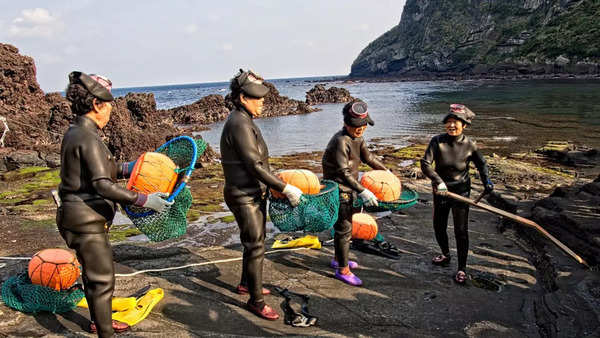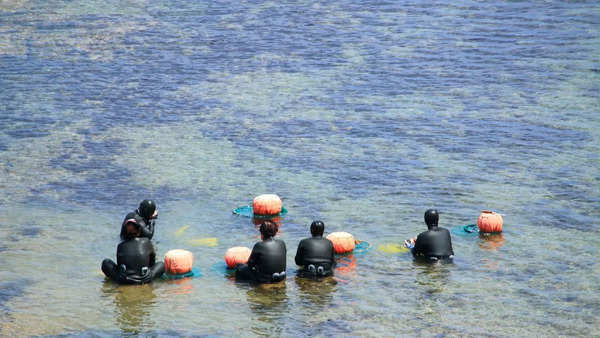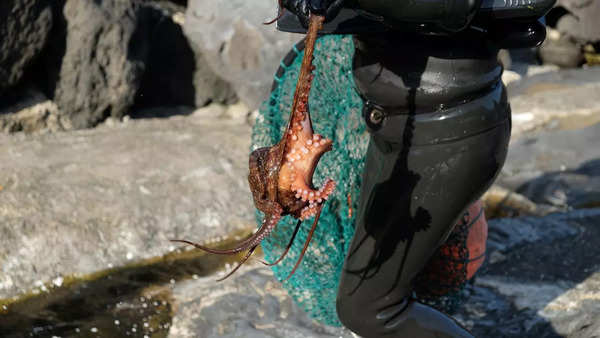They belong to the Haenyeo community. It is an incredible community of female free-divers that resides on Jeju Island. These women are the queens of the freezing waters of the South China Sea which they explore without any modern equipment even at their ripe age.
The Haenyeo is a special community of female-free divers living on Jeju Island (Credits: iStock)
Who are the Haenyeo women?
The Haenyeo is a special community of female-free divers living on Jeju Island. They are mainly old women today because the younger generations have opted for other careers. These divers dive as deep as 10 meters below the icy waters of the South China Sea without the aid of air tanks and other modern equipment providing better insulation. As one observes them , they cannot feel the frost, because their visible excitement and contagious laughter make the beach warm.
The Haenyeo are often referred to as the ’90-year-old mermaids of Korea’ because most of them are very old, and their bodies can bend like those of a mermaid in water.

the Haenyeo are a higher social rank in South Korea’s patriarchal society. (Credits: iStock)
When were the Haenyeos first noticed?
The first accounts of the Haenyeo date back to 1629. For 350 years, they wore mulsojungi, which are cotton diving clothes. It was in the 1970s that they started wearing rubber wetsuits. These divers gather shellfish such as abalone and sea urchins, as well as kelp and other marine organisms, using a knife or their fingers. These women effortlessly bring out organisms like octopuses in their hands, which is a delightful sight for the tourists.

Many of these divers are in their old age, but they can still dive with such agility and endurance. (Credits: iStock)
Range of the diving season:
For Jeju, the diving season is short, women only dive about 90 days a year. They dive underwater for several minutes and always drag behind them an orange buoy so that they can be located by fellow divers. On return to the water’s surface, they make a whistling sound. Also known as the ‘Mothers of the Sea’ and ‘Warriors against the Sea’, these women are categorised into three tiers of experience: sanggun (most experienced), hagun, and junggun. The more experienced divers guide the less experienced ones, instructing them in the crucial breathing technique called sumbisori. The Haenyeo bond forever, dividing all harvests evenly and caring for each other’s
trials by life, pregnancy, illness, and crisis.

These women effortlessly bring out organisms like octopuses in their hands, which is a delightful sight for the tourists. (Credit: iStock)
Haenyeo’s set up a matriarchal society
In contrast, the Haenyeo are a higher social rank in South Korea’s patriarchal society. The reasons why free-diving turned out to be a female-dominated profession on Jeju remain unclear, with theories including men perishing in deep-sea fishing accidents or wars, to physiological advantages like women’s fat reserves providing better resistance to cold water. A semi-matriarchal society in Jeju had been reported since many families there used to rely on income brought home by the Haenyeo. This was also a time when women were the breadwinners and men were literally staying at home to take care of the children. This role reversal could also be seen in dowry practices payment of money or goods to the bride’s family instead of the groom’s. Unlike mainland South Korea, families in Jeju often preferred the birth of baby girls over boys.
Current status and the way forward:
Recently, Haenyeo culture has declined with increased industrialization, new education and job opportunities for girls, and the environmental degradation of Jeju Island. The culture of Haenyeo was declared on the UNESCO Intangible Cultural Heritage list in 2016 because of its unique history and fast-rapid decline of female divers. It has brought the people of this island a new tourist industry, better protection and funding of the women in the industry and the natural environment of the island. The government provides free healthcare, and the necessary diving equipment, and has opened a diving school and museum. This new heritage status has benefited the community; however, in the process, the women have become ‘living artifacts‘ who perform their work as spectacle pieces for tourist audiences. Now, one can pay to see them dive and even buy their catch.







